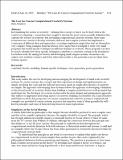The Case for Concise Computational Creativity Systems
Author(s)
Montfort, Nick
DownloadDraft of a chapter to appear in Spanish translation in the book Creatividad Computacional (133.1Kb)
OPEN_ACCESS_POLICY
Open Access Policy
Creative Commons Attribution-Noncommercial-Share Alike
Terms of use
Metadata
Show full item recordAbstract
In formalizing the notion of creativity – defining that concept so that it can be dealt with in the context of computing – researchers have sought to develop the most concise possible definition that captures the essence of creativity. But in building computational creativity systems, these same researchers are content to develop extremely elaborate and complex systems that implement a cornucopia of different ideas and approaches, or perhaps implement single ideas that are themselves very complex. Using examples from the literary arts, I argue that it is helpful to write very small programs that model specific techniques in different domains of creativity. These programs can then
be used to identify how those specific techniques contribute to creativity, serving as the foundation for further work. By aiming for brevity and developing small, elegant systems, researchers can explore new aesthetic territory and better relate their results to the particular ways in which their
systems operate. Keywords: constraint, brevity, modeling, domain-specific techniques, story generation, poetry generation
Date issued
2015Department
Massachusetts Institute of Technology. Program in Comparative Media Studies/WritingJournal
Creatividad Computational
Publisher
Grupo Editorial Patria
Citation
Mantfort, Nick. "The Case for Concise Computational Creativity Systems." Creatividad Computational. Edited by Rafael Pérez y Pérez, Grupo Editorial Patria, 2015.
Version: Author's final manuscript
ISBN
9786077442820
6077442828